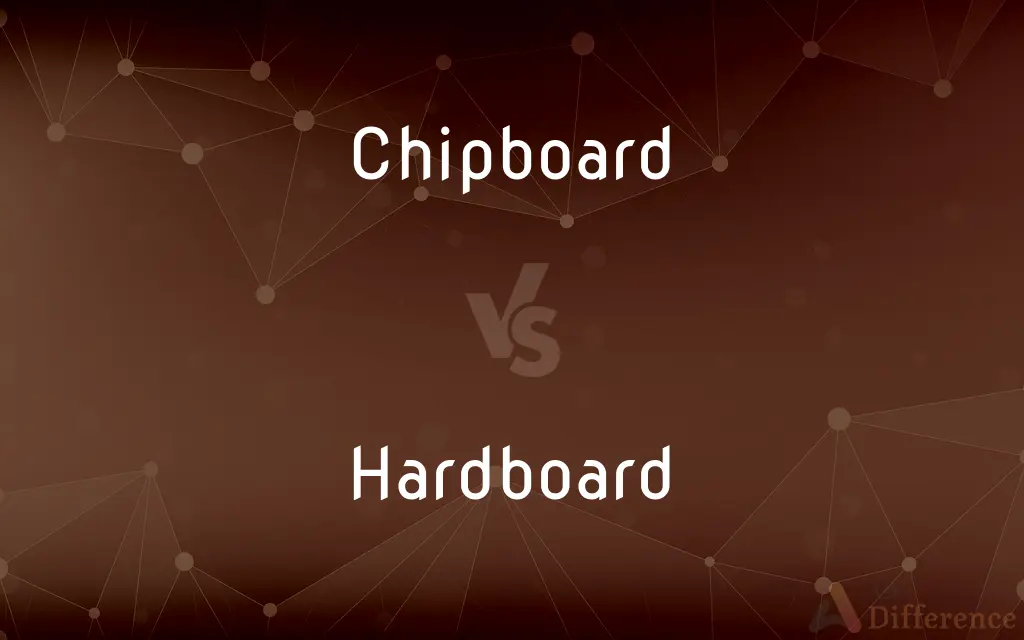Chipboard vs. Hardboard — What's the Difference?
Edited by Tayyaba Rehman — By Fiza Rafique — Updated on March 10, 2024
Chipboard is a cost-effective, lightweight material made from pressed wood chips, ideal for furniture and shelving, while hardboard is denser, stronger, and smoother, used in flooring and paneling.

Difference Between Chipboard and Hardboard
Table of Contents
ADVERTISEMENT
Key Differences
Chipboard, composed of wood chips and sawdust bonded together with resin, is an economical choice for interior projects like cabinetry and flooring underlayment. On the other hand, hardboard is made by compressing wood fibers with high pressure and heat, resulting in a denser and more durable material suitable for more demanding applications such as wall paneling and temporary flooring.
The manufacturing process of chipboard involves the use of synthetic resins and binders to hold the wood particles together, making it less eco-friendly. Whereas hardboard, often made through a wet process without added binders, can be considered a greener option.
In terms of surface finish, chipboard typically has a rough and uneven texture, requiring veneers or laminates for a smoother appearance. Conversely, hardboard offers a smooth, uniform surface that can be painted or used as is for a variety of finishes.
When it comes to strength and durability, chipboard is less resilient and more prone to damage from moisture and heavy loads. In contrast, hardboard boasts superior strength and moisture resistance, making it a better choice for areas subject to high wear and tear.
Chipboard is generally lighter and easier to cut and handle, which makes it suitable for DIY projects and lightweight furniture. Hardboard, with its higher density, is heavier and might require more effort to manipulate, but it offers a sturdier end product.
ADVERTISEMENT
Comparison Chart
Composition
Wood chips and sawdust with resin
Compressed wood fibers
Durability
Less durable, prone to moisture
More durable, better moisture resistance
Surface Texture
Rough, requires finishing
Smooth, can be used as is
Eco-friendliness
Less eco-friendly
More eco-friendly, often without binders
Weight
Lighter, easier to handle
Heavier, more solid
Compare with Definitions
Chipboard
A type of engineered wood product made from wood chips and particles bonded together with synthetic resin.
The bookshelf was made of chipboard, making it affordable yet functional.
Hardboard
A type of fiberboard made by compressing wood fibers under high heat and pressure.
The artist preferred hardboard as a durable backing for his paintings.
Chipboard
Commonly used in the manufacture of budget-friendly furniture and cabinetry.
Many flat-pack furniture pieces are made from chipboard for cost efficiency.
Hardboard
Known for its smooth surface, making it suitable for painting and finishing.
The smooth surface of the hardboard made it an ideal choice for the kitchen paneling.
Chipboard
Can be laminated or veneered for improved aesthetics.
The chipboard was covered with a wood veneer to give it a more appealing look.
Hardboard
More dense and durable than many other wood products, including chipboard.
Hardboard was used for the floor in the high-traffic area due to its durability.
Chipboard
Not highly resistant to moisture or heavy loads.
The chipboard shelving began to sag under the weight of heavy books.
Hardboard
Often used in construction and furniture for its strength.
The designer chose hardboard for the chairs to ensure they could withstand heavy use.
Chipboard
Suitable for use as a subflooring material due to its cost-effectiveness.
The contractor used chipboard as a subfloor layer under the laminate flooring.
Hardboard
Resistant to moisture compared to other engineered woods.
The bathroom cabinet was made of hardboard to prevent damage from humidity.
Chipboard
A pasteboard made from discarded paper.
Hardboard
Hardboard, also called high-density fiberboard (HDF), is a type of fiberboard, which is an engineered wood product. It is used in furniture and in the construction industry.
Chipboard
A building material made from wood chips compressed and bound with synthetic resin.
Hardboard
A construction board made by compressing fibers of wood chips usually with a binder at a high temperature.
Chipboard
A cheap hard material made from wood chips that are pressed together and bound with synthetic resin.
Hardboard
A high-density chipboard.
Chipboard
A cheap hard material made from wood chips that are pressed together and bound with synthetic resin
Hardboard
A cheap hard material made from wood chips that are pressed together and bound with synthetic resin to form sheets, used in construction and various other purposes; - called also particle board and chipboard.
Hardboard
A cheap hard material made from wood chips that are pressed together and bound with synthetic resin
Common Curiosities
Is chipboard eco-friendly?
Chipboard uses wood waste, but the resins and binders can be less eco-friendly.
Is hardboard waterproof?
Hardboard is more moisture resistant than chipboard but not entirely waterproof.
How is hardboard manufactured?
Hardboard is made by compressing wood fibers under high heat and pressure, often without added binders.
What is chipboard used for?
Chipboard is commonly used for furniture, cabinetry, and as a subfloor material.
Can you paint over hardboard?
Yes, hardboard's smooth surface makes it ideal for painting.
Is chipboard easy to work with?
Chipboard is lightweight and easy to cut, making it user-friendly for DIY projects.
Can chipboard be used outdoors?
Chipboard is not suitable for outdoor use due to its poor moisture resistance.
What makes hardboard a good choice for paneling?
Hardboard's smooth surface and durability make it suitable for wall paneling.
What is the main difference between chipboard and hardboard?
The main difference lies in their density, durability, and manufacturing process.
Does hardboard swell with moisture?
Hardboard is more moisture resistant but can still swell if exposed to water for prolonged periods.
Is chipboard cheaper than hardboard?
Chipboard is generally cheaper than hardboard due to its lower durability and strength.
Can hardboard be used for flooring?
Hardboard can be used as a temporary flooring solution or underlayment.
Why is chipboard not recommended for heavy loads?
Due to its composition, chipboard can sag or break under heavy weight.
Are there different grades of hardboard?
Yes, hardboard comes in various grades, including standard, tempered, and oil-tempered, each suited to different applications.
How can chipboard's appearance be improved?
Chipboard is often laminated or veneered to enhance its appearance.
Share Your Discovery

Previous Comparison
Good vs. Decent
Next Comparison
Matter vs. SubjectAuthor Spotlight
Written by
Fiza RafiqueFiza Rafique is a skilled content writer at AskDifference.com, where she meticulously refines and enhances written pieces. Drawing from her vast editorial expertise, Fiza ensures clarity, accuracy, and precision in every article. Passionate about language, she continually seeks to elevate the quality of content for readers worldwide.
Edited by
Tayyaba RehmanTayyaba Rehman is a distinguished writer, currently serving as a primary contributor to askdifference.com. As a researcher in semantics and etymology, Tayyaba's passion for the complexity of languages and their distinctions has found a perfect home on the platform. Tayyaba delves into the intricacies of language, distinguishing between commonly confused words and phrases, thereby providing clarity for readers worldwide.














































